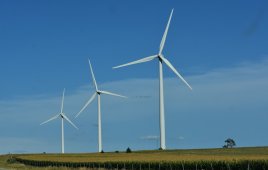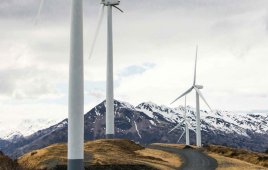Maggie Yancey, Energy Technology Program Specialist, Wind and Water Power Technologies Office
The Department of Energy’s Wind for Schools program helps to develop a wind energy workforce by educating students across the country on the value of wind energy and the bright future accessible through careers in wind. Here are five things you likely didn’t know about Wind for Schools:
1) STUDENTS FROM KINDERGARTEN THROUGH COLLEGE CAN PARTICIPATE IN WIND FOR SCHOOLS.
The Wind for Schools (WfS) program engages students from kindergarten through college on the benefits of a career in the wind energy industry. WfS encourages students at colleges and universities to join Wind Application Centers (WACs) at their schools and serve as project consultants for small wind turbine installations at rural elementary and secondary schools. Teacher training and hands-on curricula are implemented at each K-12 host school to bring wind energy into the classroom experience through interactive and interschool research tasks, engaging young people interested in science.

Teacher training and hands-on curricula are implemented at each K-12 host school to bring wind energy into the classroom experience through interactive and interschool research tasks, engaging young people interested in science.
2) WIND FOR SCHOOLS IS IN 12 STATES…AND COUNTING
Early work has focused on supporting efforts at the WACs located at higher education institutions in the states of Alaska, Arizona, Colorado, Idaho, Illinois, Kansas, Montana, Nebraska, North Carolina, Pennsylvania, South Dakota, and Virginia. The Wind Programrecently announced that it has partnered with the Distributed Wind Energy Association (DWEA) to support the long-term sustainability of the WfS program. DWEA will sustain the existing WACs and help make connections within the wind industry. DWEA’s backing will also help with examining current and potential organizational structures, new funding opportunities, and an implementation plan. WfS looks forward to adding more participant schools at the existing WACs and an additional state in the near future.
3) WIND FOR SCHOOLS IS MAKING A DIFFERENCE IN RURAL COMMUNITIES ACROSS AMERICA
For example, since 2014, Grassfield High School (GHS) in Chesapeake, Virginia, has powered its football stadium’s concession stand with a WfS turbine. Tom Spencer, the faculty advisor at GHS for the turbine project, said, “It’s an exclamation point on our school’s commitment to sustainability across our program.” GHS receives additional support from its WAC, the Center for Wind Energy at James Madison University, which lent its hydraulic lift to GHS during installation. Additionally, the university assists with cataloguing its turbine data on an online open-source website called OpenEI, which is connected with the entire WfS network. GHS has enjoyed its time in the WfS program, and its experience shows how a school can self-support a wind turbine in its community.
4) WE’RE MAKING THE WIND FOR SCHOOLS PROGRAM EVEN BETTER

About 147 WfS turbines across the country provide clean, renewable energy, and, hands-on learning opportunities to thousands of students at public K-12 schools.
This year, the WfS program is receiving new funding to jump start new initiatives and strengthen existing ones. Currently, there are 147 WfS turbines across the country providing clean, renewable energy, and, more importantly, hands-on learning opportunities to thousands of students at public K-12 schools. The classes and passionate teachers are inspiring students to learn not just about renewable energy, but about science and technology concepts in mechanical, electrical, and aeronautical engineering. The 12 college- and university-based wind energy programs, also known as WACs, serve as project consultants and mentors for their K-12 partner schools, allowing participating WAC students to gain valuable experience. To date, the WACs have graduated hundreds of students working on deploying small wind energy systems and conducting wind-related research. The new funding will expand these efforts and continue to grow a more robust WfS network.
5) WIND ENERGY IS THE FUTURE – GET INVOLVED
In 2015, wind was the top technology choice for electricity generation in the United States—supplying 41% of new generating capacity—and it’s largest source of new renewable power generation added in the nation since 2000. Career opportunities are also increasing in the wind industry: 2015’s healthy construction season, combined with the growing need to operate and maintain more than 48,500 turbines, has brought the total number of U.S. wind industry jobs to 88,000.
WfS works closely with KidWind Project and the National Energy Education Development Project to provide hands-on, interactive curricula that are supported through teacher training workshops in each state. The National KidWind Challenge joined the Department of Energy’s Collegiate Wind Competition this past May at the AWEA WINDPOWER conference in New Orleans. Click on the links above to learn about these opportunities and new ways to incorporate learning about wind energy into your home or classroom.
Subscribe to the WINDExchange’s bi-weekly newsletter to receive regular updates and announcements on the DWEA Wind for Schools Sustainability Plan development.
The Office of Energy Efficiency and Renewable Energy accelerates development and deployment of energy efficiency and renewable energy technologies and market-based solutions that strengthen U.S. energy security, environmental quality, and economic vitality. Go to wind.energy.gov to learn more about our Wind Program’s funding opportunities and efforts to develop innovative technologies capable of generating renewable, environmentally friendly, cost-competitive electricity from wind resources. To learn more about the WINDExchange’s Wind for Schools program, view the Wind for Schools website.
Filed Under: Community wind, News, Policy




